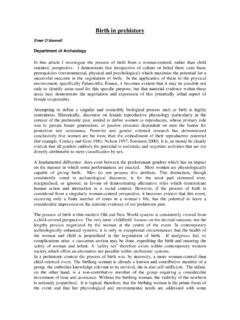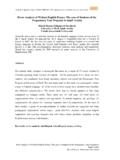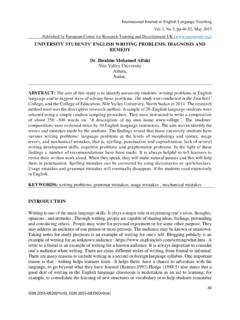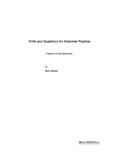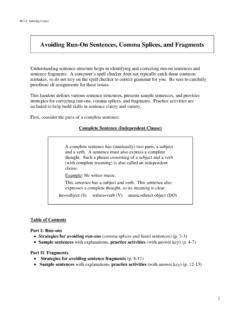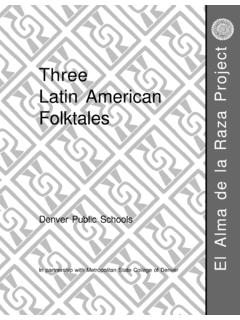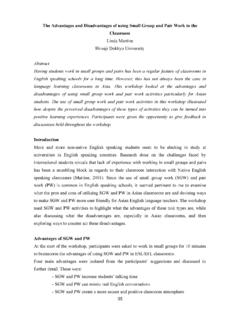Transcription of iej.cjb.net Native language interference in learning a ...
1 International Education Journal Vol 1, No 1, 1999 language interference in learning a secondlanguage: Exploratory case studies of Native languageinterference with target language usageBaljit BhelaFlinders University School of EducationIntroductionThe second language learning environment encompasses everything the language learner hears andsees in the new language . It may include a wide variety of situations such as exchanges inrestaurants and stores, conversations with friends, reading street signs and newspapers, as well asclassroom activities, or it may be very sparse, including only language classroom activities and afew of the learning environment, the learner s goal is mastery of the target language .
2 Thelearner begins the task of learning a second language from point zero (or close to it) and, throughthe steady accumulation of the mastered entities of the target language , eventually amasses them inquantities sufficient to constitute a particular level of proficiency (Dulay, Burt & Krashen, 1982and Ellis, 1984).This characterisation of language learning entails the successful mastery of steadily accumulatingstructural entities and organising this knowledge into coherent structures which lead to effectivecommunication in the target language (Rutherford, 1987). If this is the case, then we would expectthat well-formed accurate and complete target language structures would, one after another, emergeon the learner s path towards eventual mastery of the language .
3 If the learner went on to masterthe language , we could, in principle, tabulate the expansion of his/her repertoire up to the pointwhere all of the well-formed structures of the target language had been accounted for (Beardsmore,1982 and Hoffman, 1991).In reality this is not the case. Second language learners appear to accumulate structural entities ofthe target language but demonstrate difficulty in organising this knowledge into appropriate,coherent structures. There appears to be a significant gap between the accumulation and theorganisation of the knowledge. This then raises a critical question - what kinds of language dosecond language learners produce in speaking and writing?
4 When writing or speaking the targetlanguage (L2), second language learners tend to rely on their Native language (L1) structures toproduce a response. If the structures of the two languages are distinctly different, then one couldexpect a relatively high frequency of errors to occur in L2, thus indicating an interference of L1 onL2 (Dechert, 1983 and Ellis, 1997).Previous Research and the Importance of this ResearchExtensive research has already been done in the area of Native language interference on the targetlanguage. Dulay et al (1982) define interference as the automatic transfer, due to habit, of thesurface structure of the first language onto the surface of the target language .
5 Lott (1983: 256)defines interference as 'errors in the learner s use of the foreign language that can be traced back tothe mother tongue'.Bhela23 Ellis (1997: 51) refers to interference as transfer , which he says is 'the influence that the learner sL1 exerts over the acquisition of an L2'. He argues that transfer is governed by learners perceptions about what is transferable and by their stage of development in L2 learning . Inlearning a target language , learners construct their own interim rules (Selinker, 1971, Seligar, 1988and Ellis, 1997) with the use of their L1 knowledge, but only when they believe it will help themin the learning task or when they have become sufficiently proficient in the L2 for transfer to (1997) raises the need to distinguish between errors and mistakes and makes an importantdistinction between the two.
6 He says that errors reflect gaps in the learner s knowledge; theyoccur because the learner does not know what is correct. Mistakes reflect occasional lapses inperformance; they occur because, in a particular instance, the learner is unable to perform what heor she appears to be much more difficult for an adult to learn a second language system that is as welllearned as the first language . Typically, a person learns a second language partly in terms of thekinds of meanings already learned in the first language (Carroll, 1964; Albert & Obler, 1978 andLarson-Freeman & Long, 1991). Beebe (1988) suggests that in learning a second language , L1responses are grafted on to L2 responses, and both are made to a common set of meaningresponses.
7 Other things being equal, the learner is less fluent in L2, and the kinds of expressionshe/she uses in L2 bear telltale traces of the structure of (1964) argues that the circumstances of learning a second language are like those of amother tongue. Sometimes there are interferences and occasionally responses from one languagesystem will intrude into speech in the other language . It appears that learning is most successfulwhen the situations in which the two languages (L1 and L2) are learned, are kept as distinct aspossible (Faerch and Kasper, 1983). To successfully learn L2 requires the L2 learner to oftenpreclude the L1 structures from the L2 learning process, if the structures of the two languages aredistinctly (1982) suggests that many of the difficulties a second language learner has with thephonology, vocabulary and grammar of L2 are due to the interference of habits from L1.
8 Theformal elements of L1 are used within the context of L2, resulting in errors in L2, as the structuresof the languages, L1 and L2 are relationship between the two languages must then be considered. Albert and Obler (1978)claim that people show more lexical interference on similar items. So it may follow that languageswith more similar structures (eg English and French) are more susceptible to mutual interferencethan languages with fewer similar features (eg English and Japanese). On the other hand, we mightalso expect more learning difficulties, and thus more likelihood of performance interference atthose points in L2 which are more distant from L1, as the learner would find it difficult to learnand understand a completely new and different usage.
9 Hence the learner would resort to L1structures for help (Selinker, 1979; Dulay et al, 1982; Blum-Kulka & Levenston, 1983; Faerch &Kasper, 1983, Bialystok, 1990 and Dordick, 1996).Dechert (1983) suggests that the further apart the two languages are structurally, the higher theinstances of errors made in L2 which bear traces of L1 structures. In both cases the interferencemay result from a strategy on the part of the learner which assumes or predicts equivalence, bothformally and functionally, of two items or rules sharing either function or form. More advancedlearning of L2 may involve a greater number of rules or marking features for distinguishing betweenthe two languages.
10 This then raises a pertinent question - does the L2 text have to be syntacticallycorrect for its meaning to be understood? Do the identified errors in the written text reduce24 Native language interference in learning a second languagesemantic and syntactic acceptability? The answer lies in several domains: the L2 learner s purposein learning the target language , the learner s L2 proficiency level of the target language and theknowledge state of the learner in L1 and focus of the case studies is on specific instances of L1 interference on L2 in the syntacticstructures of the second language learner s writing. The present study also identifies the effect ofthe differences and/or similarities between the structures of L1 and L2 on the target case studies concentrate on the effect of each of the areas of difficulty identified on a nativespeaker s interpretation of the written text.



